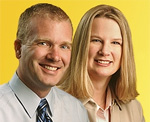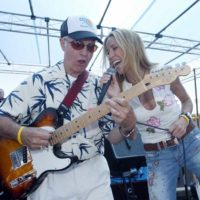I haven’t listened to it yet, but Sunny points us to an in-depth interview –and live performance– with Sheryl Crow on NPR’s Fresh Air. Stayed up watch her perform a pretty good version of Doctor My Eyes on Letterman. The woman looks fine. Downloading her new album, Detours.
Tag Archives: Interview
Jim Lipsey
Jim Lipsey was one of Learfield’s first employees. He was part of the KLIK gang (Derry Brownfield and Bob Priddy) that helped Clyde Lear get the company up and running.
On Friday we got Clyde, Jim and Bob in a studio to talk about those early days and Jim’s contributions (there were many). Jim will be 87 his next birthday. I want to be him when I grow up. When I joined the company in 1984, Jim showed me the ropes of affiliate relations. It was a privilege to work with him. Here’s 10 minutes from a half-hour chat.
Radio: As good as it gets?
In a recent interview with Mark Ramsey (Hear 2.0), marketing smart-guy Seth Godin talked about his new book, The Dip, and how some of the ideas therein apply to the future of radio.
MSTA Podcast: The Pulse
 Todd Fuller and Gail McCray produce and co-host The Pulse, a weekly podcast for the Missouri State Teachers Association. The 25 podcasts they’ve produced since January, 2006, cover a wide variety of topics. When I listened to one of their podcasts last week, I was immediately struck by the quality and professionalism of the production. Not sure why I was surprised, since they’re both communications pros but it drove home one more time that anyone with something to say now has the means to be heard.
Todd Fuller and Gail McCray produce and co-host The Pulse, a weekly podcast for the Missouri State Teachers Association. The 25 podcasts they’ve produced since January, 2006, cover a wide variety of topics. When I listened to one of their podcasts last week, I was immediately struck by the quality and professionalism of the production. Not sure why I was surprised, since they’re both communications pros but it drove home one more time that anyone with something to say now has the means to be heard.
Near the end of the 30 minute chat (AUDIO), Todd mentions something I found very interesting. The association endorses political candidates and it’s a big deal (at least to the candidates). Typically those announcements would be made via news release to the big newspapers and media outlets. This year, MSTA plans to make the announcement on their podcast as well as putting the word out via blogs. I think that is brilliant I’ll bet they get a lot of play out of it.
Todd and Gail are making great use of podcasting and I have no doubt other associations will see the impact of what MSTA is doing and jump in the water.
PS: In addition to Todd and Gail, you’ll hear David Brazeal in a couple of places… but we lost him due to my lack of experience with Skype.
Making radio relevant again
I’ve been reading Douglas Rushkoff’s latest book (Get Back In theBox: Innovation from the Inside Out) and was delighted to come across an interview with Rushkoff at Radio Marketing Nexus. Mark Ramsey talked with Rushkoff about “how to make radio relevant again.” Ruskoff misses the same things about radio that I do. AUDIO
“Because of my book tours I’ve been in a lot of radio stations, and even from 1995 to 2005 the amount of change I’ve seen has been shocking. There used to be this kind of quality to an FM radio station – I hate to be stereotypical, but there was a certain kind of chick who would be the receptionist at an FM radio station. There was a certain kind of guy that worked in the album room organizing the albums. There was a certain kind of geek figuring out the emphasis rack.
But FM stations are not really like that anymore. They feel much more like almost any other office, and if you didn’t see the control room you wouldn’t know you were in a radio station at all. They don’t ooze their culture anymore.
There was a smell and a quality and a texture to everything radio that I think was the fun of the industry. There was something so real about it. In the early days when I was a kid, you had Ron Lundy and Cousin Brucie – you just somehow knew those guys were there even though they were playing top 40 stuff. You knew it was a world of guys with records and personalities. And there’s so little of that on the radio today.
There’s almost nothing in mainstream radio that has that sense of this as a club of people in a cool place having a great time sharing some of their ecstasy with those of us driving to work or sitting in our bedrooms who wanted to have a taste of what it’s like to be an adult who understands music, who reads “Rolling Stone,” who understands why we’re fighting the Gulf War, or whatever it is. And I want to piece of that.
When I turn on the radio now I don’t feel that these folks have a piece of anything that I can’t get a piece of by going into Allstate to work in the morning. It’s just another working stiff with some computer telling them what to play and when to play it and when to read the ads.
I don’t trust the voice behind the music anymore because I don’t know that he’s really an expert or that he really cares. He’s not part of a living, breathing, fertile culture whereas if I go online and look at these Podcasts I know these people have done it not for the money but for the love of it. And radio is going to have to go a long way now to convince me that there’s somebody there who cares about what they’re doing for some reason other than the cash.
Finally, I would say the purpose of radio is to keep people company. And in order to keep people company there’s got to be a human being on the other side of it. The more truly human your radio station is the better it is at keeping people company. And the more computerized and business-like it is the farther outside the box you’ll find yourself.”
So there you have it. The pure, distilled essence of what’s wrong with radio today. And it seems like it would be very easy to fix. To get back in the box. But I fear we don’t even remember where we put the box.
Sheryl Crow Aquatic Center
Kennett, Missouri hasn’t had a public swimming pool since they demolished the ancient, aboveground monster that people my age grew up with. But thanks to the generosity of hometown-girl-turned-superstar Sheryl Crow (and others), they now have the Sheryl Crow Aquatic Center. The nine-time Grammy winner came to take part in the dedication ceremonies on Saturday and Barb and I were there for the big splash.
I don’t know Sheryl Crow (I don’t know any big stars) but she seems like one very classy, very smart, very down-to-earth lady. She still sees herself as a Kennett girl. That’s home. And she’s concerned that the little town has fallen upon hard times, economically. So she wrote ’em a check for a million bucks to build a municipal swimming pool just off the downtown “square.” Which is slowly dying. Some would say dead.
But Ms. Crow is giving more than her money to help revitalize the town. She’s giving her time and her name and a little of her wonderful talent. She performed a few songs with a local band, The Usual Suspects. Her daddy, Wendell, plays guitar in the band when he’s not lawyer’ing.
I’m terrible at estimating crowds because I avoid them like the plague, but I’d guess there were three or four hundred [The DDD reports 4,000] folks on hand and it was a beautiful morning. I got to see a lot of old friends, many of whom I had not seen in 20 years. I took a bunch of photos while Barb manned the camcorder. We’ll get some video posted as soon as I have time to edit.
Following the performance, Sheryl held a little pool-side news conference [5 min] for the half dozen TV and radio stations on hand.
AUDIO: News conference 5 min MP3
(Rumor: A crew from ABC’s 20/20 was following Sheryl around for some upcoming segment) When no one could come up with a coherent question, Sheryl took over and explained why she got involved in the project. Not sure if you’ll be able to hear it, but I thought the best question came from Barb, who wanted to know Sheryl’s best stroke when she was on the high school swim team (breast stroke).
I don’t know that a new swimming pool will save my old home town but I’m proud of all those folks for trying.
Special thanks to Kennett correspondent Charles Jolliff for link to photos of Kennett’s old municipal pool. UPI Super Photog Bill Greenblatt for the photo above and others. And Jan McElwrath and Randy Morgan with the Kennett Chamber of Commerce for organizing a great a event making us feel so welcome.
Adopt a sniper
“Help real snipers get the real gear they need to help keep us safe.” The most amazing thing about this website is that there is a need for it. We send these people into combat without the stuff they need so the folks back home provide it. Update: WRN reporter Bob Hague interview with Keith Deneys, director of Adopt A Sniper. [8 min/mp3]
Radio Iowa interview with Laura Bush
O. Kay Henderson’s exclusive interview with the First Lady continues to generate interest by other media outlets. She’s scheduled to appear on C-SPAN’s “Road to the White House” (a weekly look at the candidates, issues & events shaping the 2004 Presidential race). The program airs Sundays on C-SPAN at 6:30pm ET & 9:30pm ET.
Mary Quass on radio and the Internet
Mary Quass is a really smart, really nice lady that’s been very successful in the radio business. I haven’t seen the full interview yet but today’s issue of RAIN pulled some excerpts from the May 26, 2003 issue of Radio Ink Magazine:
“This (Internet) is the first technology to mean that anybody can have a radio station as good as, if not better, than what’s out there today — and it has nothing to do with a license. I want to be in and out of the business by then… “
“When I go to the gym to work out, you know what I do? I listen to MP3s on my Rio. If I grew up with radio and I’m listening to MP3s, why should we expect young people to listen to radio when their lives are so packed with other things? That’s why, when the Internet becomes wireless, I want to be there.’.. “
“Radio has taken for granted that we will always have 96 percent of the adult population listening to this medium in a week. But we know that response rates and that kind of stuff are declining — not so much because Arbitron’s methodology necessarily is flawed or archaic, as much as it is that people want what they want when they want it.”
“It’s all about the product. If you have a great product and it’s in demand, people will use that product. If we don’t differentiate our product when the Internet becomes wireless, it will be a whole new ball game for all of us. We had better be ready, or the frustration we feel will only grow.”
You think?




